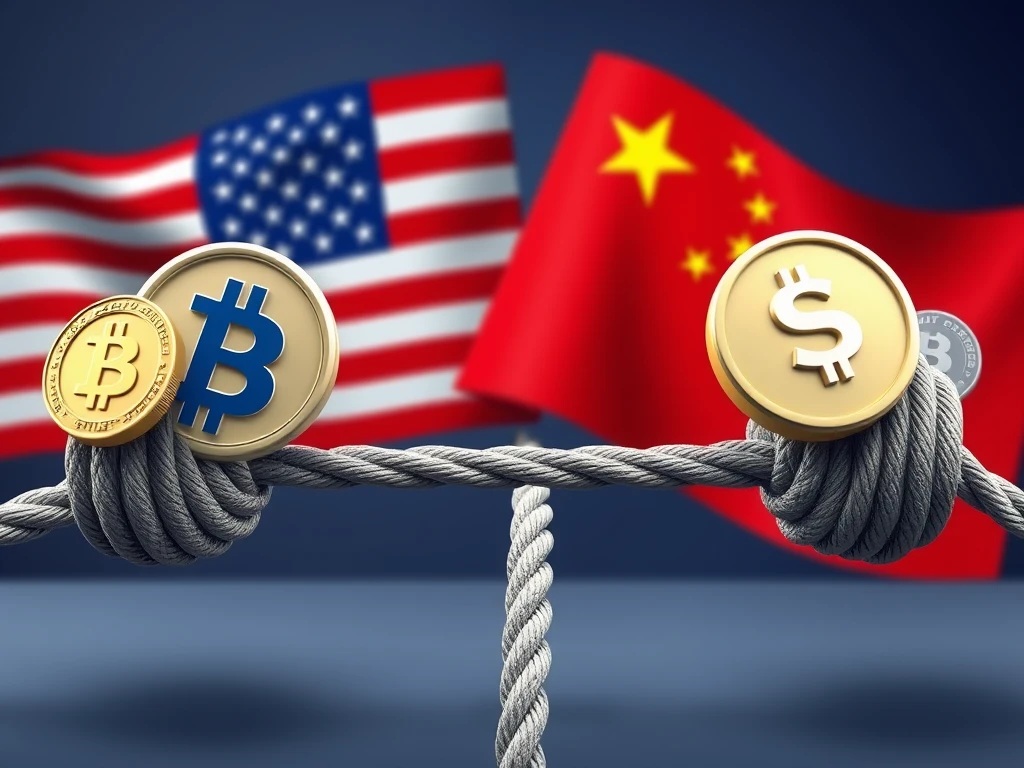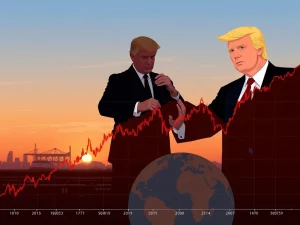Escalating Trade War Threatens Crypto and Stocks: Expert Analysis

Are you feeling the market jitters? The ongoing trade tensions between the US and China have entered a concerning “new phase,” sending ripples through both cryptocurrency and traditional stock markets. Investors are on edge as tariffs escalate, impacting everything from tech stocks to your favorite altcoins. Let’s dive into what’s happening and what it means for your investments in this turbulent economic climate.
US-China Trade War Escalates: A New Phase for Markets
The global economic landscape is shifting once again as the United States and China engage in a fresh round of tariff escalations. On April 15th, the White House announced significant tariffs on Chinese imports, reaching up to a staggering 245%. This includes a “125% reciprocal tariff, a 20% tariff to address the fentanyl crisis, and Section 301 tariffs on specific goods, ranging from 7.5% to 100%.” This aggressive move signals a hardening stance and a potential deepening of the trade war.
According to Aurelie Barthere, a principal research analyst at Nansen, this isn’t just another trade skirmish. We’ve entered a “new phase” focusing on high-value sectors like tech and pharmaceuticals, specifically targeting US-China relations. This heightened tension is creating a climate of uncertainty, making “expensive assets” like cryptocurrency and tech stocks particularly vulnerable.
Why Crypto and Stocks are Feeling the Heat
It’s not industry-specific fundamentals driving the market sensitivity, but rather a fragility in investor confidence and market positioning. Barthere emphasizes that until a resolution emerges—potentially through direct dialogue and concessions—risk assets will remain highly correlated and under pressure. This correlation has been evident since November 2024, intensifying during recent market corrections as investors seek to reduce risk, especially from assets perceived as expensive.
Consider these key factors influencing market behavior:
- Tariff Escalation: Increased tariffs directly impact company profits and supply chains, creating economic uncertainty.
- Geopolitical Risk: The US-China tension is a major geopolitical risk factor, making investors wary of holding riskier assets.
- Thin Confidence: Market confidence is easily shaken by macroeconomic news, leading to rapid de-risking behavior.
- Positioning Sensitivity: Market positioning is currently “thin,” meaning fewer participants are holding strong long positions, making markets more volatile to news events.
Stocks and Crypto Correlation: What Does It Mean for Your Portfolio?
The correlation between US equities and cryptocurrency has been notably high since late 2024. This means that when the stock market dips, crypto tends to follow suit, and vice versa. This correlation intensifies during market downturns as investors broadly “de-risk,” selling off assets across the board. The chart below illustrates this trend, showing Bitcoin (BTC), S&P 500 (SPX), Nasdaq, and gold movements.
[Chart Placeholder: BTC, SPX, Nasdaq, gold chart. Source: Crypto News Insights/TradingView]
While gold is often seen as a safe haven, even its traditional role is being tested in this environment. The strong correlation suggests that broad macroeconomic factors, like the US China trade situation, are overriding asset-specific fundamentals for now.
Will the Market Recover? Eyes on the Federal Reserve
Market analysts at Nansen predict a 70% chance of global equities and cryptocurrency markets bottoming out by June 2025 before a potential recovery. However, this recovery is heavily contingent on the direction of global tariff negotiations and the broader macroeconomic environment.
All eyes are now fixed on US Federal Reserve Chair Jerome Powell’s upcoming speech at the Federal Open Market Committee (FOMC) meeting on May 6th. With both tariff tensions and inflation concerns looming, the market is keenly awaiting any signals about potential shifts in Fed policy.
Bitfinex analysts point out that markets are particularly sensitive to hints of delayed rate cuts due to “sticky inflation or heightened geopolitical risk.” A hawkish stance from Powell could trigger further downside for risk assets like Bitcoin. Conversely, a neutral or balanced tone might provide some much-needed calm, especially after recent recoveries in many risk assets, particularly in the lower market cap crypto space.
Navigating the Uncertainty: Key Takeaways
In this “new phase of trade war,” understanding the interplay between macroeconomic factors and market sentiment is crucial. Here’s what you should consider:
- Stay Informed: Keep a close watch on US-China trade developments and Federal Reserve communications.
- Manage Risk: Be aware of the high correlation between crypto and stocks and manage your portfolio risk accordingly.
- Consider Long-Term: Market volatility may present buying opportunities for long-term investors, especially if you believe in the fundamental value of cryptocurrency and tech innovation.
- Watch Powell’s Speech: Jerome Powell’s upcoming remarks could be a significant market catalyst.
The current market reaction isn’t about fundamental shifts in crypto or tech, but about “thin” positioning and sensitive confidence. As the tariffs drama unfolds, strategic investors who stay informed and manage risk wisely can navigate these turbulent waters and potentially capitalize on future opportunities. The next few weeks, particularly around the FOMC meeting, will be critical in setting the tone for market direction.








